Thermostatic mixer: how to choose and install a mixer with thermostat
Double-valve and single-lever water taps are installed on the sinks for mixing cold and hot water. They are extremely easy to operate and cheap.
But when the pressure in the pipes changes, their valves have to be tightened so that the flow temperature returns to the desired parameters. It would be nice to automate this process, right?
Modern thermostatic the mixer allows you to level out this small but annoying inconvenience. The range of models from various manufacturers is so rich that it is quite difficult to choose the right option. Do you have difficulty choosing? Or did you decide to install such a mixer yourself, but are you afraid of accidentally breaking something?
We will help you clarify these issues - the article describes the device, the principle of operation and the existing types of thermostat valves. A step-by-step installation algorithm is also provided.
In addition, we picked up informative photos, visual diagrams and detailed video instructions that will help any beginner choose the best mixer and master the installation process.
The content of the article:
The principle of operation of the household mixer with thermostat
Changing the pressure and temperature in the water supply pipes is an unpleasant situation faced by residents of both apartment buildings and private cottages. This is especially annoying in the morning, when the stream from the tap in the washbasin becomes either too hot or too cold.
This happens due to the fact that everyone in the house at this time begins to intensively use water for washing and bathing. Its consumption increases sharply, causing pressure drops.
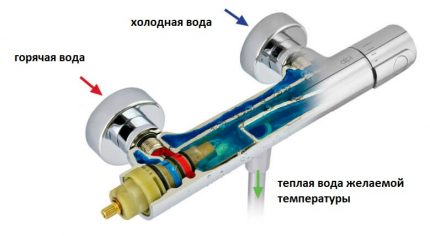
According to domestic standards, the temperature DHW in a centralized system can range from 50 to 70 degrees. The spread is large enough.
For public utilities this is a blessing, they may not have to worry much about going beyond the limits of standards. And consumers are forced to suffer from inconvenience. We have to install special control devices or constantly adjust water supply in the tap.
Here thermostat mixers come to the rescue, all models of which are divided into three categories:
- Mechanical.
- Electronic.
- Non-contact.
The first are the most simple and affordable. The required temperature and water pressure are adjusted in them by means of a lever or valve, and the preset parameters are maintained by pure mechanics and changes in the physical properties of the internal elements of the device.
The second and third are already composed of electronic components that require constant power supply.
Type # 1 - instruments with mechanical adjustment
The functioning of this type of mixer is based on the movement of a movable valve inside the device, which responds to changes in the parameters of the mixed water stream.
If the pressure increases in one pipe, the cartridge simply shifts and reduces the flow of water coming in for mixing from the other. As a result, the temperature in spout remains the same.
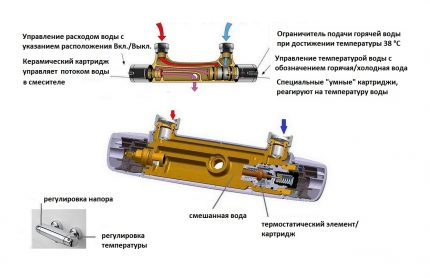
The internal moving valve contains material that sensitively and quickly responds to all changes in temperature of the water entering the mixing device.
In most cases, synthetic wax acts as a sensitive thermocouple sensor. Under the influence of temperature, it contracts and expands, which leads to the displacement of the locking cartridge.
Many mechanical models have a fuse on the control valve that limits the maximum temperature to 38 ° C. For a person, such indicators are considered the most comfortable.
But even in the absence of a fuse, hot water from 60-65 degrees thermostatic the mixer will not leak. Everything is designed so that when the specified temperatures are reached, the wax expands to the maximum, and the valve blocks the pipe DHW - completely. Burns from boiling water are excluded here by definition.
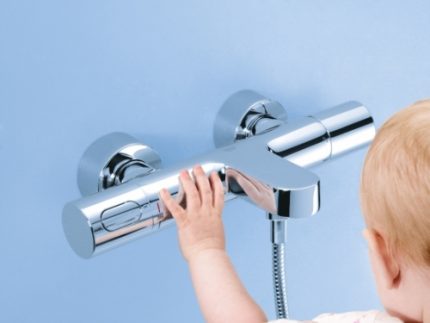
Valve displacement occurs almost instantly inside. Any change in the temperature of the incoming water or its pressure leads to an immediate expansion / contraction of the thermocouple.
As a result, even strong fluctuations in flow parameters in pipes DHW and Hvs do not affect the overall jet in spout. Water will flow from it exclusively with user-specified indicators.
Some models use bimetallic plates instead of wax. The principle of their action is similar.Under the influence of temperature, they bend and shift the valve to the desired depth.
Type # 2 - devices with electronic filling
Mixers with electronic thermostats are more expensive, technically more complicated and require power supply. They connect to the outlet through a network adapter or have a battery in their composition, which must be replaced regularly.
The electronic temperature controller is controlled by:
- remote buttons or on the mixer body;
- sensors;
- remote control.
Water indicators in this device are monitored by electronic sensors. In this case, all the numbers are displayed on a special LCD screen. The display often shows both temperature and pressure. But a variant with only one value is possible.
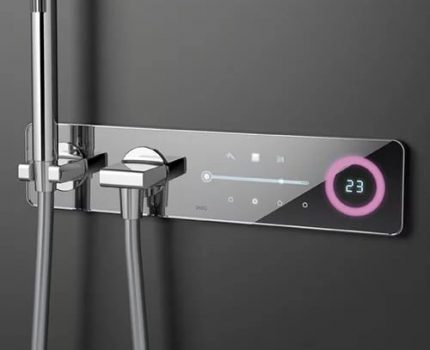
Often in everyday life, an electronic mixer-thermostat with a display is a device with excess functionality. Such equipment is more suitable for installation in medical institutions or other public institutions.
It is much more common in shower pools and toilet rooms in office buildings than in the kitchens or in bathrooms of private cottages.
However, if construction is planned "Smart home" with all sorts of simplifying life gadgets, then a mixer with an electronic thermostat is just what is required. He certainly will not interfere in such a dwelling.
In addition to automatically controlling the water temperature for greater comfort in the bathroom, you can equip a warm floorso as not to depend on the mood of heat supply organizations in the cold season.
Choosing a faucet for the kitchen and bathroom
The principle of operation for all thermostatic faucets is similar. With the help of the adjustment, the required temperature is set once, and then the water supply valve simply opens.
They function identically, however, the model range is quite extensive. And each device has its own individual characteristics with advantages.
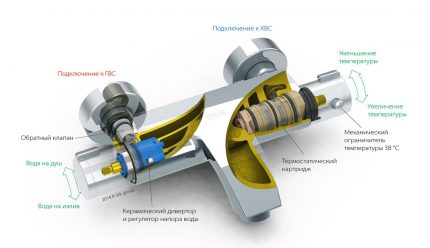
By purpose and installation point thermostatic taps are divided into four categories:
- for washing in the kitchen;
- with spout exclusively for the washbasin;
- for bidet;
- with shower head and spout for Bath.
They are installed on a wall, countertop or plumbing fixture using an open installation method. Or they are mounted in a closed way, when only the valves or levers and spout are visible. And all the internal parts with this installation are hidden behind the cladding on the wall.
Most often, thermostatic faucets are mounted in the bathroom. In the kitchen they are not so in demand. The temperature of the water in the kitchen sink has to be constantly changed - either cold for drinking or filling the kettle, warm for washing food, or hot for washing dishes.
Continuously switching the fuser setting is not recommended. Yes and the convenience of availability thermostatic mixer in this case is reduced to almost zero. And in the shower and washbasin, the temperature is exactly what is required to be constant. Here it is more relevant.
Pros and cons of various models
Mechanical mixers with an integrated thermostat are more reliable than electronic counterparts. They will cost less than their counterparts. And in the event of a breakdown, they are easier to repair.
But the models with the display are more accurate and easier to manage. But they can be repaired in case of malfunction only in a specialized center.
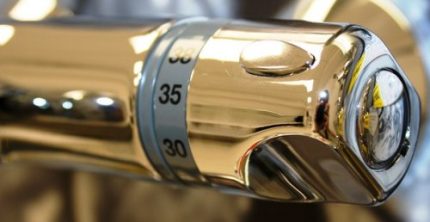
Electronic devices are regulated smoothly, allowing you to specify in the settings any parameters in the working range for a specific model. However, they do require power. In case of power outages, there is a risk of not only being left without electricity, but also of losing water supply.
Domestic water faucets with thermostat:
- provide the necessary pressure with a stable temperature;
- completely safe in operation;
- reduce water overruns;
- easy to do it yourself;
- exclude scalding and getting under an ice shower;
- save energy (if installed in an autonomous hot water supply system).
Their only drawback is the high cost. However, in return - comfort, economy and safety.
What to look for when choosing?
The material of manufacture of the mixer body should be carefully selected:
- bronze, copper or brass - the most durable and expensive;
- ceramics - not as reliable as metal, but it looks more attractive;
- silumin (aluminum-silicon alloy) - cheap and short-lived;
- plastic - the lowest price and lowest reliability.
It’s even more important to choose the right material for the thermostat shutoff valve. Leather and rubber options are cheap, but wear out quickly enough. If solid suspensions get into the tap with water, these gaskets can quickly fail.
Compared to a conventional mixer, their wear rate in thermostatic similar to an order of magnitude higher. So it’s not long to bring the matter to a flood and clarification of relations with neighbors from below.
It is best to choose high strength ceramic valves. They themselves are durable and the saddle will not hurt.
But if the mixing device is installed precisely with them, then you should forget about the use of force when tightening the valve until it stops. The valve is unlikely to break, but the head of the thermostat will be torn off quickly.

The main problem of most faucets with thermostats is the differences in standard piping layouts for hot and cold water pipes in Russia and Europe.
We have a pipeline DHW according to the standard, the plumbing device is led to the right, and they have to the left. However, these devices were mainly developed and manufactured by European manufacturers, according to their rules.
When choosing thermostatic It is extremely important for the faucet to find out from the seller how to connect the water pipes to it. If the pipes are connected the other way around, then the thermostat will simply break.
Devices for baths and bidets must be adapted to Russian standards. Otherwise, you will have to change the configuration of the pipes, and this is an additional serious cost.

And the last moment is the availability of sufficient pressure in the water supply. In the passports thermostatic Mixers indicate a minimum working pressure of 0.5 bar.
If in the pipes it is actually lower, the device will not be able to work properly. There is simply no sense in installing it in such a plumbing system.
Leaders in the production of heat mixers
When choosing a thermostat mixer, preference should be given to models specially made for Russia.
Recently, foreign manufacturers began to produce this plumbing under domestic standards and requirements. It is her who should be looked for in stores, so as not to rack their brains after installation.

In the domestic market, faucets with a built-in thermostat are represented by the following brands:
- Oras (Finland);
- Cezares and Gattoni (Italy);
- Grohe, Kludi, Vidima and Hansa (Germany);
- Lemark (Denmark);
- Toto (Japan);
- NSK (Turkey);
- Idddis and SMARTsant (Russia).
The Germans are the undisputed leaders in this industry. But other manufacturers are trying to keep up, creating a line of different price classes.
Here it is more necessary to focus on the materials of manufacture and design of the product. However, one should not forget about the positive image won over the years.
Mixing tap installation with thermostat
In general, the installation of the mixer in question is practically no different from installation of an analog of a conventional design without thermostat. It is only necessary not to make a mistake with the points of connecting hot and cold water to the device. Confusion will inevitably damage the thermostat.
If you cannot deploy the mixer for proper connection, you will have to swap the supply pipelines. This is most easily done using flexible hoses. But it may be necessary to rebuild the wiring of the water supply system in the immediate vicinity of the mounted tap.
The installation procedure is as follows:
- The supply of hot and cold water at the riser is shut off.
- The existing crane is dismantled.
- Eccentric discs are installed on the pipes with their dilution under a new mixer.
- They are installed on their intended places of laying and decorative elements.
- The mixer with the thermostat is screwed.
- Mounted parts (spout, watering can) are mounted.
- Water is turned on, and then the operability of the installed device is checked.
- The temperature of the water coming from the mixer-thermostat is adjusted.
To prevent leaks, a tow, FUM tape or other equivalent is used as a sealant.
Coarse filters and check valves should be installed on the water supply. Thermostatic the mixer is quite demanding on the quality of the water entering it.
On the one hand, care should be taken to ensure that there is no other sediment in the sludge stream, and on the other hand, even the potential flow between pipes should be eliminated. Hvs and DHW. This fitting can not be mounted in only one case, if it is already in the housing of the mixing device.
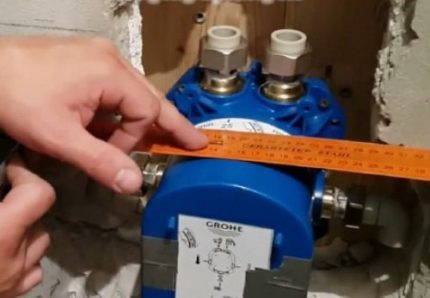
With flush mounting to the wall, only the spout and buttons or thermostat adjustment lever are visible. Everything else is closed by decor. The bathroom takes on a finished look. Just the perfect option, however, if the mixer breaks down, you will have to break the walls and remove the tiles to repair it.
Calibration of the temperature controller is carried out by means of a special adjustment screw or valve under the protective cover of the device. For this you will need a conventional thermometer and a screwdriver.
If the thermostat is not calibrated in accordance with the passport instructions, then the temperatures at the mixer valve can actually vary greatly.
Do you like original bathroom solutions? Then you may be interested in the information about the mixer-waterfall, considered in this article.
Conclusions and useful video on the topic
Overview of the mixing valve with thermostatic control in the bathroom:
How the thermostat mixer works:
Step-by-step installation guide thermostatic mixer GROHE:
Advantages of thermostatic mixer weight. The main obstacle to its mass use is the high cost of this device for many Russians.
An ordinary faucet with a mixing chamber without a thermostat will cost several times cheaper. But if comfort and safety are more important for you, then you should spend money on equipment with a built-in thermostat.
Do you use a thermostatic mixer? Perhaps you installed it yourself? Please share your impressions of using such a smart device - what disadvantages have you found for yourself, and what pleases you the most.
Or are you just picking up a mixer model? Or maybe you have difficulties during the installation process - ask your questions in the comments section, and we will try to help you.

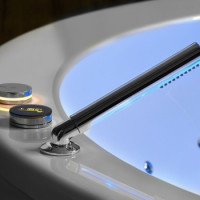 Thermostatic bath and shower faucet: device, principle of operation and selection rules
Thermostatic bath and shower faucet: device, principle of operation and selection rules 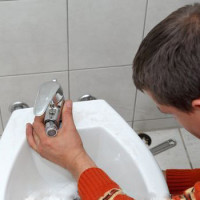 How to Install a Bidet Mixer: Installation and Connection Guide
How to Install a Bidet Mixer: Installation and Connection Guide  How to choose a bathroom faucet: a review of the types and rating of the best faucets
How to choose a bathroom faucet: a review of the types and rating of the best faucets 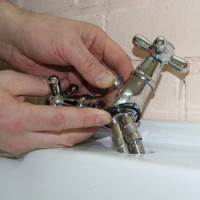 How to install the mixer on the sink: a detailed analysis of installation technology
How to install the mixer on the sink: a detailed analysis of installation technology 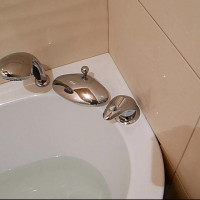 How to install the mixer on board the bath: step-by-step installation instructions
How to install the mixer on board the bath: step-by-step installation instructions 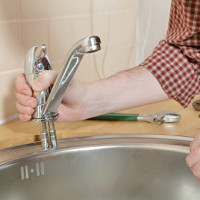 How to install a faucet in the kitchen: step-by-step instruction on the work
How to install a faucet in the kitchen: step-by-step instruction on the work  How much does it cost to connect gas to a private house: the price of organizing gas supply
How much does it cost to connect gas to a private house: the price of organizing gas supply  The best washing machines with dryer: model rating and customer tips
The best washing machines with dryer: model rating and customer tips  What is the color temperature of light and the nuances of choosing the temperature of the lamps to suit your needs
What is the color temperature of light and the nuances of choosing the temperature of the lamps to suit your needs  Replacement of a geyser in an apartment: replacement paperwork + basic norms and requirements
Replacement of a geyser in an apartment: replacement paperwork + basic norms and requirements
Most recently, I had a question with the choice of a faucet in the bathroom. I immediately went to the plumbing store. There they did not tell me anything sensible, since not very educated people work in their team. I decided to find a solution to my answer on the Internet. Quite by chance I came across this Internet resource, climbed it and in the end I bought a thermostatic mixer of a mechanical type. Everything is working well now.
How to establish a “friendship” between a thermostatic mixer and a dual-circuit gas boiler? In this pair, the mixer works fine, and the boiler is constantly starting.
Well, they should already interact normally, no problems should arise, in theory, should not. If it starts to clock, then you can try to set the temperature on the boiler closer to the maximum and gradually reduce it until it starts to work normally. Although I do not quite understand why you even need this thermostat on the mixer. For me it’s not the most convenient thing.
We bought a thermal mixer (with mechanical adjustment) on the advice of sellers in the store for a lot of money. After installation, there was either boiling water or cold water. The plumber, not particularly educated, immediately said “to dismantle the apparatus and install an ordinary mixer”.
We don’t know what to do. Can this be configured manually? Plumbers who would understand such devices, probably, do not exist. What can be done in this situation?